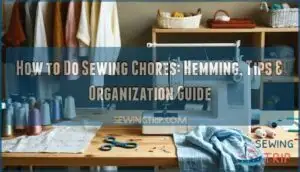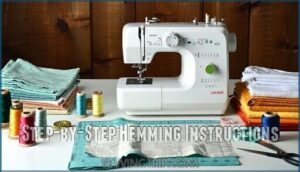This site is supported by our readers. We may earn a commission, at no cost to you, if you purchase through links.
 You fasten a button in thirty seconds, but a fallen hem might sit in your closet for months. Sewing chores pile up not from difficulty but from hesitation—most tasks require only basic skills and ten minutes of focused work.
You fasten a button in thirty seconds, but a fallen hem might sit in your closet for months. Sewing chores pile up not from difficulty but from hesitation—most tasks require only basic skills and ten minutes of focused work.
Thread a needle, fold fabric twice, and stitch a straight line: that’s hemming stripped to its essentials. Whether you’re decoding crossword clues that hint at textile tasks or actually fixing those pants bunched in your mending basket, understanding core techniques transforms overwhelming repairs into manageable routines.
The difference between wearing clothes that fit and abandoning garments entirely often comes down to mastering a few foundational skills.
Table Of Contents
Key Takeaways
- Most sewing repairs take under fifteen minutes to complete, but people postpone them for months—mastering basic techniques like hemming, button replacement, and seam repair eliminates this hesitation and keeps your wardrobe functional.
- "Does a sewing chore" is a common crossword clue with "HEMS" as the standard answer, referring to the action of folding and stitching fabric edges to adjust garment length.
- Organizing sewing tasks by urgency and complexity—from quick button fixes to weekend alterations—transforms overwhelming mending piles into manageable projects you’ll actually finish.
- Creating an efficient sewing space with proper lighting, organized tools, and entertainment like music or podcasts turns tedious repairs into enjoyable sessions that build practical skills.
What Does “Does a Sewing Chore” Mean?
If you’ve ever encountered the phrase "does a sewing chore" in a crossword puzzle, you might wonder what it’s actually asking for. The answer is simpler than you’d think—it’s a common task sewers tackle regularly.
Let’s break down what this phrase means, why it shows up in word games, and how "hem" and "hems" fit into your sewing vocabulary.
Common Sewing Chores Explained
Sewing chores are the everyday mending and adjustment tasks that keep your wardrobe functional—from fixing loose buttons to reattaching fallen hems. Master thread choices and fabric selection to manage these routine fixes confidently and extend your clothing’s lifespan.
You’ll tackle common sewing tasks like replacing zippers, patching torn seams, and shortening garment lengths. Hemming stands out as the most frequent repair, requiring basic sewing machines or hand-stitching skills.
Crossword Puzzle Clue Context
If you’re scratching your head over the clue "Does a sewing chore," you’re looking at a classic crossword puzzle pattern. The answer HEMS appears across major publications like the New York Times and LA Times, fitting the four-letter requirement perfectly.
Crossword constructors love this clue because it uses present-tense action verbs and textile-specific language to test your vocabulary. Answer verification across puzzle databases confirms HEMS as the standard solution, though variants like MEND (past tense) pop up for similar clues.
For more information on solving crossword puzzles, checking the crossword clue database can be very helpful.
Differences Between “Hem” and “Hems”
Understanding the difference between HEM and HEMS comes down to simple grammar—one refers to the actual finished edge of fabric, while the other describes the action of creating that edge. When you’re tackling a sewing chore, you’ll hem pants or curtains, while the finished result is called the hem itself.
In Sewing Terminology and Tailoring:
- HEM (noun): The folded edge you’ve stitched—your finished work
- HEMS (verb): The action you perform when adjusting length
- Hemming Techniques: Methods vary by Fabric Selection, Thread Choices, and available Sewing Notions
That’s why crossword clues use "hems" for "does a sewing chore"—it captures the active process every Sewing and DIY enthusiast knows well.
How to Hem Clothing Like a Pro
Hemming transforms ill-fitting pants and skirts into garments that look custom-made for you. You’ll need the right tools, a solid technique, and patience to manage common problems that pop up along the way.
Here’s what you need to master this essential skill.
Tools and Materials Needed for Hemming
You won’t get far hemming pants or skirts if you’re missing the right tools—gather your fabric scissors, measuring tape, pins, thread, and an iron before you start. A seam ripper helps fix mistakes quickly, while chalk or a fabric marker lets you mark hems accurately.
If you’re using sewing machines, check that your needle matches your fabric selection—denim needs a heavier needle than cotton. Match thread colors to your material for professional results, and keep basic sewing notions like a thimble and extra bobbins within reach.
Step-by-Step Hemming Instructions
Pin your fabric at the fold line, press it flat with your iron, and measure the desired hem width before you stitch. Use a straight stitch or blind hem stitch pattern depending on your fabric selection—thicker materials need stronger thread choices and adjusted tension settings.
For clean, professional results:
- Press each fold twice to eliminate puckers and set sharp creases
- Backstitch at start and finish to lock your seam securely
- Keep consistent seam allowance throughout the entire hem
- Test stitch patterns first on scrap fabric matching your material
Hand Sewing Vs. Machine Hemming
Choosing between hand hemming and machine hemming depends on your fabric weight, visibility concerns, and how much time you’re willing to invest in the finish.
Machine hemming delivers sewing speed and stitch quality for everyday sewing chore projects, while hand techniques like slip stitches create invisible hems on delicate fabrics.
Your thread choices and fabric selection guide which hemming techniques work best—heavyweight denim suits machine stitching, but silk requires careful hand sewing for professional results.
Troubleshooting Common Hemming Mistakes
Even experienced sewers hit snags—puckered fabric, uneven lengths, or thread tension that refuses to cooperate—but fixing these mistakes is simpler than starting over. Check your sewing machine’s tension settings first when fabric issues appear, then press seams flat before measuring.
Thread breakage often signals a dull needle—swap it out and test your sewing techniques on scrap fabric. Master garment fitting by measuring twice and addressing hemming errors early.
Tips for Making Sewing Chores Enjoyable
Sewing chores don’t have to feel like drudgery. With a few smart adjustments to your setup and mindset, you can turn repetitive tasks into something you actually look forward to.
Here’s how to make your sewing time more pleasant and productive.
Creating a Pleasant Sewing Space
Your sewing space should feel like a retreat, not a battleground—good lighting, a comfortable chair, and everything within arm’s reach can transform tedious mending into something you actually look forward to.
Invest in an ergonomic setup with proper lighting options like an adjustable lamp, and use storage solutions that keep thread, scissors, and sewing patterns organized at your sewing station.
A calming color scheme helps you tackle any sewing chore with focus.
Choosing Fun and Inspiring Projects
Not every sewing project needs to feel like work—when you pick something that sparks your curiosity or solves a real problem in your wardrobe, the needle practically threads itself.
Try these project planning strategies:
- Start with repairs that make favorites wearable again—hemming jeans or mending a beloved shirt beats any DIY fashion experiment
- Explore sewing patterns for workwear styles like chore coats that blend creative stitching with practical fabric selection
- Challenge yourself with one unfamiliar sewing technique per project to build skills without overwhelm
- Keep a "sewing ideas" list so inspiration strikes before the sewing chore does
Incorporating Music or Podcasts
A good playlist or podcast episode can turn an hour of hemming into time that flies—your hands stay busy while your mind stays entertained. Choose upbeat music for detailed work or calming instrumental sounds when you’re relaxing into repetitive stitches.
Audiobooks and sewing podcasts offer inspiration while you tackle that sewing chore—you’ll finish the hem before the episode ends.
Time Management Strategies
Breaking your sewing list into smaller tasks—fifteen minutes here, half an hour there—keeps you from burning out and helps you actually finish what you start. Set a timer for one sewing chore at a time—hemming pants before dinner or tackling buttons during lunch.
Time blocking turns chores to do into manageable wins. Track your progress with scheduling tools or simple goal setting on paper, and you’ll stay motivated without feeling overwhelmed.
Organizing and Prioritizing Sewing Tasks
Once you’ve mastered the joy of sewing, it’s time to tackle the practical side—getting organized. You can’t hem every pair of pants in one sitting, so you need a system that keeps you on track without feeling overwhelmed.
Let’s break down how to sort your pile, set goals you’ll actually finish, and know when it’s smarter to hand the work to a pro.
Sorting Clothing Needing Adjustments
Before you tackle a single stitch, gather every garment that’s been waiting for attention and spread them out where you can see the full scope of what needs fixing. Sort by urgency and complexity—this wardrobe editing approach transforms overwhelming piles into manageable tasks:
- Pants dragging on the ground (quick hem)
- Buttons hanging by a thread (five-minute fix)
- Torn seams on favorite chore coats (moderate repair)
- Complex alterations requiring pattern adjustments (weekend project)
This clothing categorization lets you prioritize what you’ll wear this week versus what can wait.
Setting Realistic Sewing Goals
Once you’ve sorted your pile, commit to finishing just one or two pieces this week instead of promising yourself you’ll fix everything by Friday. Track your progress in a simple sewing schedule—crossing off completed hems or button repairs builds real sewing motivation.
Break larger projects into timed sessions using goal-setting strategies that honor your available hours, not fantasy time. This productivity tracking approach transforms sewing chores from overwhelming tasks into achievable wins.
When to Seek Professional Help
Some repairs fall outside your skill set, and knowing when to hand off a project saves you hours of frustration and wasted fabric. Seek professional alterations when:
- Structured garments like blazers or fitted coats require reshaping—these tailoring needs demand expert guidance
- Formal wear sewing emergencies arise days before an event
- Zipper replacements or invisible closures stump you repeatedly
- Delicate fabrics (silk, leather, beaded pieces) risk permanent damage
- Complex pattern adjustments exceed your current sewing techniques and patterns knowledge
Repair services free you to tackle enjoyable projects instead.
Sewing Trends and Inspiration for Modern Makers
Sewing isn’t just about fixing what’s broken—it’s about creating something that reflects who you are and what you care about. The patterns you choose, the materials you select, and the communities you join can transform routine chores into inspired craft.
Here’s what’s shaping the sewing world right now and how you can tap into it.
Popular Patterns and Workwear Styles
Sewing trends for 2025 lean heavily on oversized workwear designs with earth-toned fabric choices—think rich browns, greens, and mustard yellows in soft linen and cotton. Popular patterns include wide-leg trousers, quilted jackets, and the Parker chore coat silhouette, blending style inspiration with practical functionality.
Gender-neutral cuts dominate, with denim jackets and minimalist power suits incorporating adjustable fit technology for everyday comfort. Designers are drawing inspiration from spring fashion trends to create unique and stylish pieces.
Sustainable and Eco-Friendly Sewing Supplies
Your choice of eco-friendly materials shapes a more sustainable future for textile work and the sewing community. Organic cotton, hemp, and linen qualify as eco fabric options, while recycled materials and biodegradable notions reduce waste.
Consider these sustainable choices:
- Green threads made from recycled polyester minimize landfill contributions
- Sustainable dyes derived from plants protect waterways during fabric manipulation
- Deadstock fabrics repurpose industry overruns for needlework projects
- Natural fiber batting replaces synthetic alternatives in quilting and weaving
These supplies grew 20–30% from 2025 to 2026, proving you can tackle sewing chores—even simple tasks like solving "does a sewing chore" in sewing and crosswords puzzles—while protecting the planet.
Joining The Sewing Community for Motivation
Connection fuels your craft—finding fellow sewists transforms solitary chores into shared triumphs and keeps your needle moving when motivation fades. Whether you’re hemming or tackling sewing and crosswords puzzles, these sewing community and resources keep your creativity flowing.
Join sewing groups through online forums or community events to swap sewing patterns and textile selection advice. Follow sewing blogs for motivation tips that blend sewing and fashion insights.
Frequently Asked Questions (FAQs)
What are some common sewing chores that people often avoid?
People delay button repairs, zipper replacements, and patching worn-out knees most often. Fabric sorting and thread management feel tedious. Sewing fears around fitting adjustments or working with delicate materials also trigger delays.
Time blocking helps tackle these common sewing chore obstacles.
How can avoiding sewing chores impact a person’s wardrobe?
Ignoring wardrobe maintenance leads to ill-fitting clothes, shortened garment longevity, and mounting repair costs. Without tackling basic clothing repair tasks, your style consistency suffers as favorite pieces pile up unworn, pushing you toward less sustainable fast-fashion purchases instead.
What are some tips for making sewing chores more enjoyable?
Your sewing space transforms the task—clear your table, add good lighting, and keep tools within reach.
Music therapy or a favorite podcast turns repetitive work into time you’ll enjoy.
Join a sewalong or sewing community for motivation and fresh project planning ideas.
What sewing chores are easiest for beginners?
Try hand-stitching buttons or mending small tears first. These beginner projects build your sewing basics and confidence with fabric choice, thread selection, and essential sewing tools before tackling larger apparel design tasks.
How often should you do sewing maintenance?
You can’t stitch together good work without regular upkeep. Clean your Sewing Machine Care station weekly, change needles every project, check Thread Quality monthly, and organize Fabric Storage seasonally—your apparel construction depends on it.
Can children safely help with sewing chores?
Yes, children can safely help with sewing chores under close supervision. Start with kid-friendly tools like plastic needles and simple beginner projects such as weaving or hand-stitching felt.
Youth education builds confidence while teaching practical skills for future sewalong sessions.
Whats the average cost of sewing supplies?
Your sewing budget varies widely. Basic thread costs $2–5, while fabric runs $5–30 per yard. Notions and tools add up fast, but supply sales help stretch your budget.
Fabric kits simplify textile selection for beginners.
How long does a typical hemming job take?
Hemming time varies widely based on fabric types and sewing speed. A simple pant hem takes 10–15 minutes by hand, or 5–10 minutes by machine. Heavier textiles like denim require more time than lightweight cotton. Thread choices and stitch length also affect duration.
With practice, you’ll master this fundamental sewing chore efficiently.
Conclusion
Seventy percent of mending projects take under fifteen minutes, yet most people wait months before tackling them. That gap between effort and action disappears once you master basic techniques.
Thread your needle, fold your fabric, and complete the task while it’s fresh in your mind. When you do a sewing chore immediately instead of postponing it, you transform your wardrobe from a pile of repairs into clothing you actually wear.
Your skills improve with each stitch, turning hesitation into habit.
- https://www.globallivingwage.org/industries/garment-textile/
- https://fashionunited.com/statistics/global-fashion-industry-statistics
- https://www.earthday.org/beneath-the-seams-the-human-toll-of-fast-fashion/
- https://guidingmetrics.com/content/key-apparel-industry-metrics/
- https://pmc.ncbi.nlm.nih.gov/articles/PMC10006435/













